Tiffany lamps are known for their intricate designs and use of colorful stained glass, making them highly sought-after collectors’ items. But some of these stunning works of art come with a hefty price tag. Here are the 10 most expensive Tiffany lamps in the world, each one a true masterpiece of craftsmanship and artistry.
10 Most Expensive Tiffany Lamps in the World
| Tiffany Lamps Name | Tiffany Lamps Price |
| Banded Dogwood Table Lamp | $52,920 |
| Tiffany Poppy Lamp | $250,000 |
| Tiffany Peacock Lamp | $314,500 |
| Fruit Table Lamp | $564,500 |
| Tiffany Wisteria Lamp | $716,000 |
| Tiffany Pebble Lamp | $760,000 |
| Tiffany Dragonfly Lamp | $884,000 |
| Trumpet Creeper Table Lamp | $2,295,000 |
| Tiffany Pink Lotus Lamp | $2,807,500 |
| Tiffany’s Pond Lily Lamp |
$3,372,500
|
Banded Dogwood Table Lamp
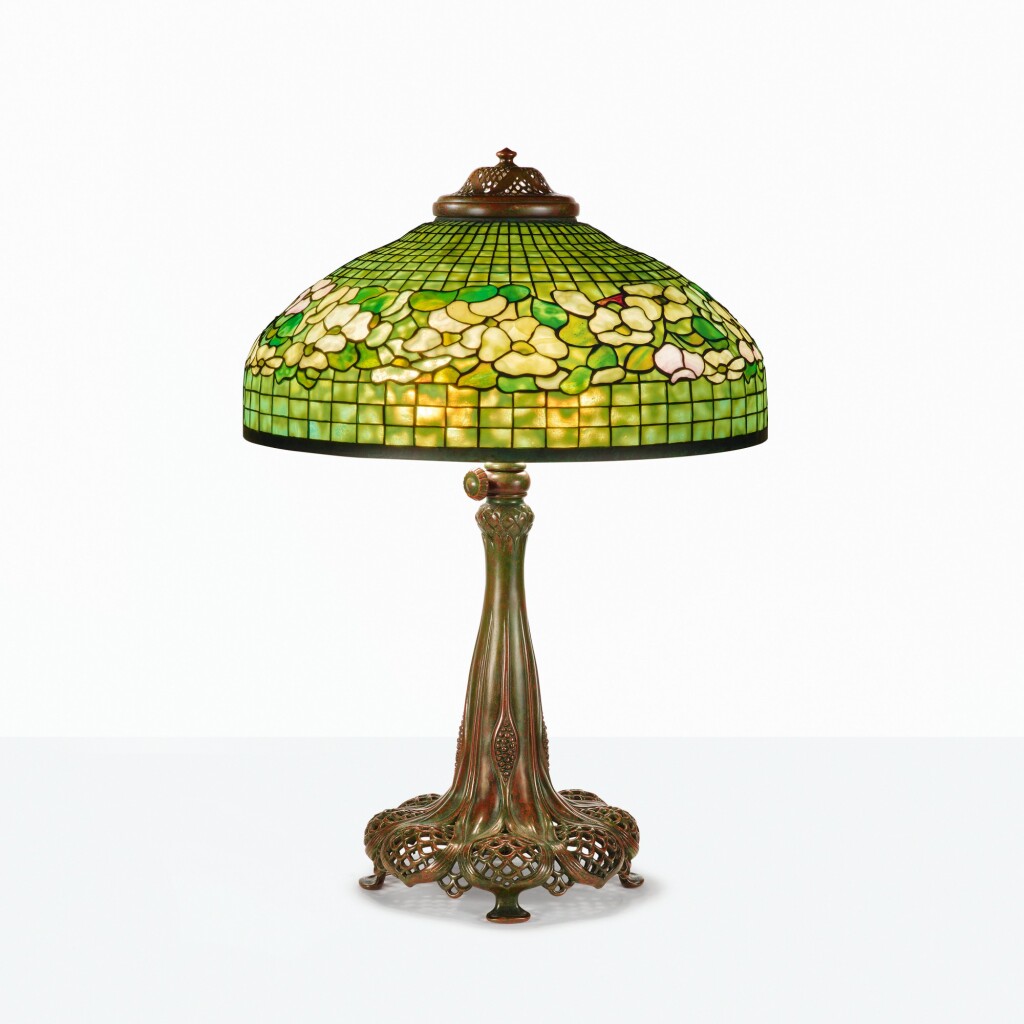
The banded Dogwood Table Lamp is the 10th most expensive Tiffany Lamp in the World. The Banded Dogwood Table Lamp is a beautiful and unique addition to any room. It features a hand-crafted ceramic base with a design inspired by the bark of the dogwood tree. The base is adorned with intricately carved details and a warm, wood-like finish. The lamp is completed with a natural linen shade, adding a touch of rustic charm to the piece. This lamp is perfect for a cozy living room or bedroom, providing a soft, warm glow that creates a welcoming atmosphere. It is sure to become a conversation piece and a beloved addition to any home.
Tiffany Poppy Lamp
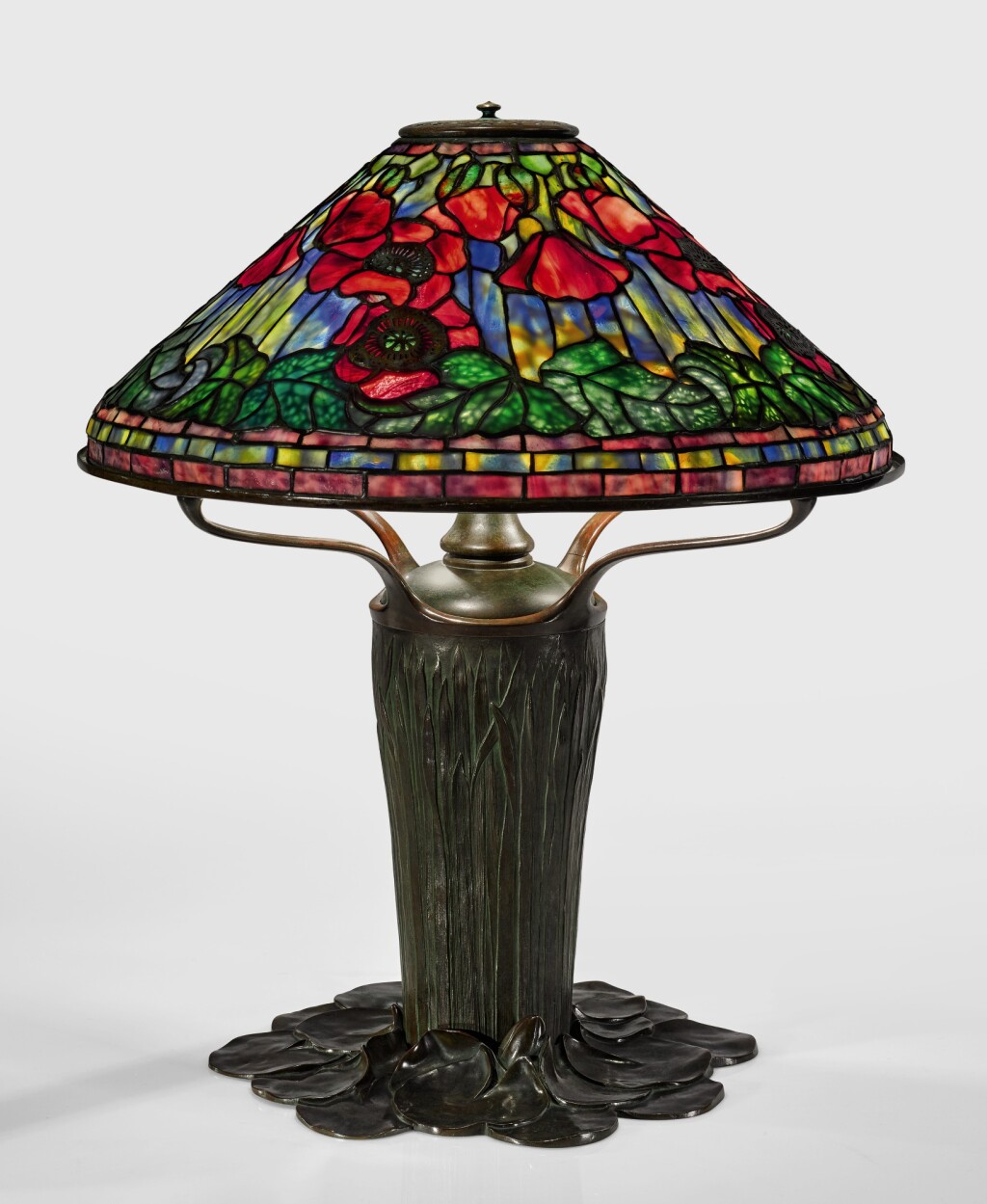
Tiffany Poppy Lamp is the 9th most expensive Tiffany Lamp in the World. The Tiffany Poppy Lamp is a beautiful piece of art glass lighting created by Louis Comfort Tiffany in the early 20th century. It features a base made of bronze or metal with a poppy flower design, and a shade made of stained glass in vibrant red and orange hues. The lamp is designed to add a touch of elegance and beauty to any room it is placed in and is often used as a decorative piece in living rooms, bedrooms, and office spaces. The Tiffany Poppy Lamp is known for its intricate detailing and high-quality craftsmanship, making it a beloved and highly sought-after piece for collectors and enthusiasts of Tiffany lighting.
Tiffany Peacock Lamp
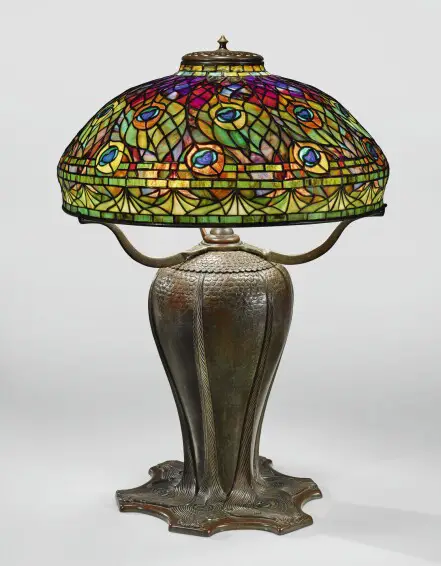
Tiffany Peacock Lamp is the 8th most expensive Tiffany Lamp in the World. The Tiffany Peacock Lamp is a beautiful and unique piece of lighting that is perfect for any home. It features a stunning peacock design, with intricate details and vibrant colors. The lamp is made from high-quality materials, including stained glass and brass, and is expertly crafted to ensure durability and long-lasting beauty. The Tiffany Peacock Lamp is a great addition to any room and is sure to add a touch of elegance and sophistication. It is a perfect choice for those who love nature, art, and luxury.
Fruit Table Lamp
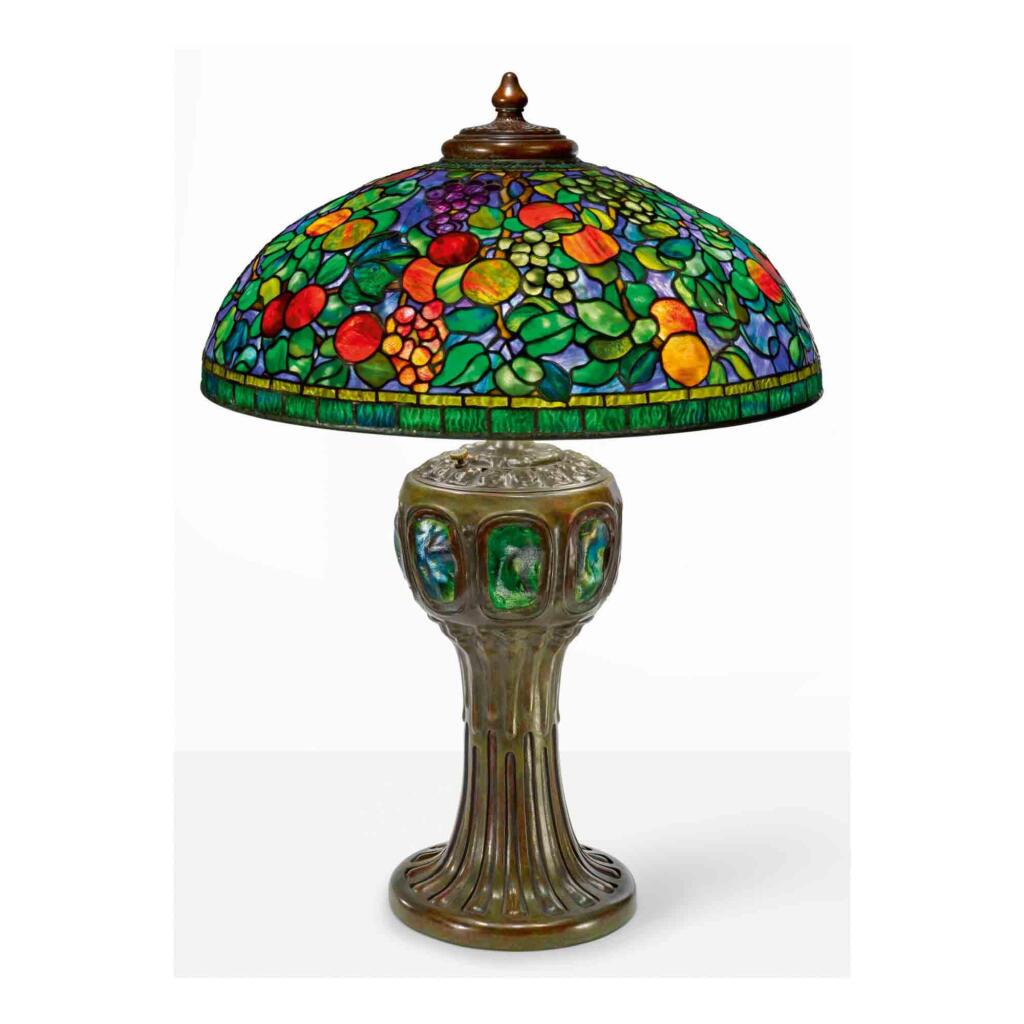
Fruit Table Lamp is the 7th most expensive Tiffany Lamp in the World. This fruit table lamp is a unique and fun addition to any room. The base of the lamp is shaped like a bunch of ripe, colorful fruits, including apples, pears, bananas, and more. The lampshade is made of translucent white fabric, allowing the light to shine through and create a warm, cozy atmosphere. The lamp is perfect for a kitchen or dining room, adding a touch of whimsy and playfulness to the space. It is also a great gift for anyone who loves fruit or has a love of all things quirky and unusual.
Tiffany Wisteria Lamp
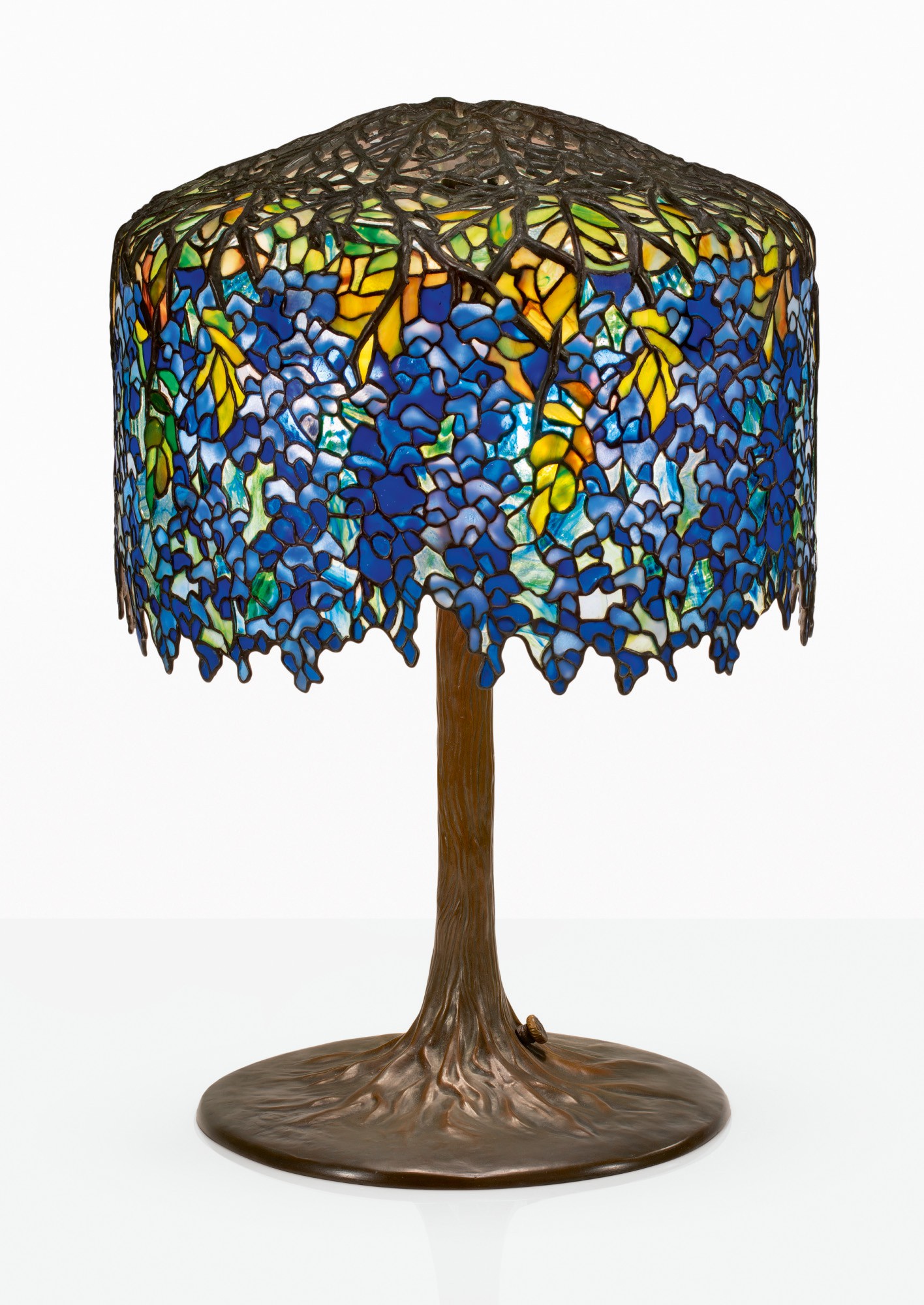
Tiffany Wisteria Lamp is the 6th most expensive Tiffany Lamp in the World. The Tiffany Wisteria Lamp is a beautiful and intricate piece of lighting artwork. It features a wisteria flower design that has been handcrafted using colorful stained glass. The lamp base is typically made of metal, with a brass finish that adds to its classic charm. The lampshade is made of hundreds of individual pieces of glass, each cut and shaped to fit together like a puzzle. When the light is turned on, the glass pieces come to life, casting a warm and colorful glow around the room. This lamp is perfect for adding a touch of elegance to any room in your home.
Tiffany Pebble Lamp
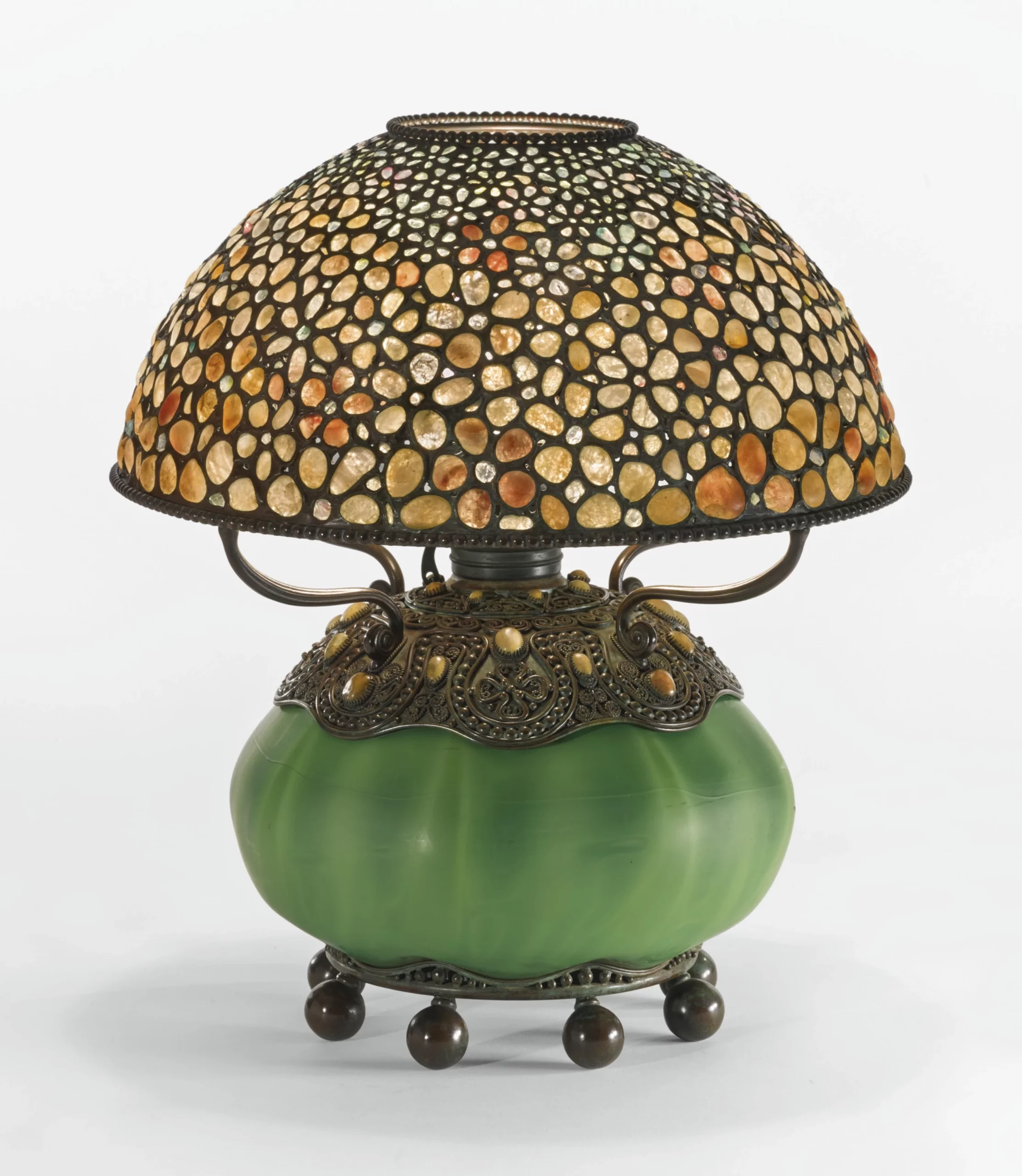
Tiffany Pebble Lamp is the 5th most expensive Tiffany Lamp in the World. The Tiffany Pebble Lamp is a beautiful piece of lighting that is perfect for any room in your home. It features a handcrafted base made of pebbles that have been carefully placed to create a unique and intricate design. The shade is made of stained glass and features a warm, inviting color palette that adds a touch of elegance to any space. The Tiffany Pebble Lamp is a true masterpiece and is sure to be the focal point of any room it is placed in.
Tiffany Dragonfly Lamp
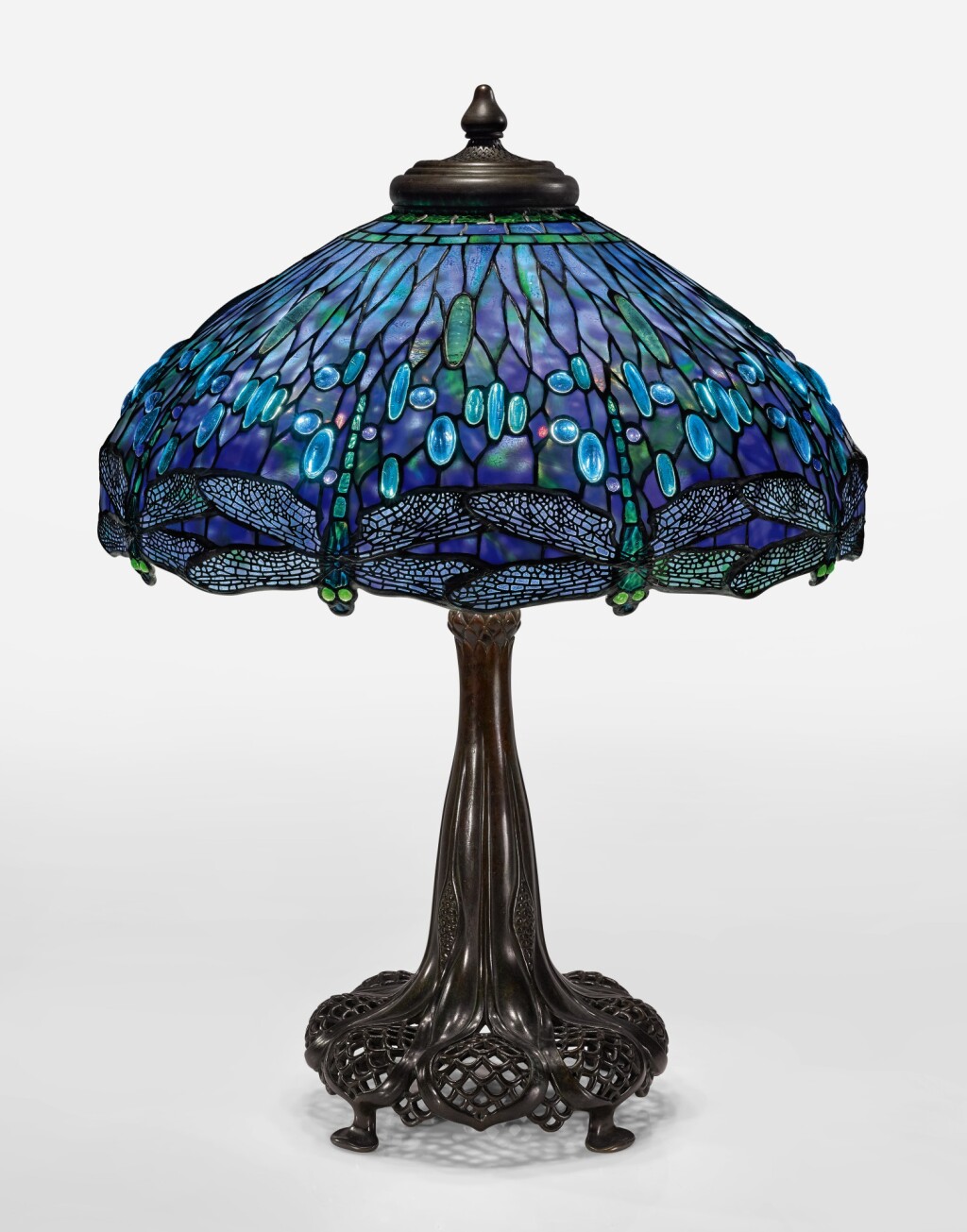
The Tiffany Dragonfly Lamp is the 4th most expensive Tiffany Lamp in the World. The Tiffany dragonfly lamp is a beautiful and intricate piece of lighting that is sure to add a touch of elegance to any room. It features a stunning dragonfly design, with intricate details and vibrant colors. The lamp is made from high-quality materials and is designed to last for many years to come. The dragonfly lamp is the perfect addition to any home or office and is sure to be a conversation starter for anyone who sees it. Whether you are looking to add a touch of whimsy or simply want to add a unique piece to your home, the Tiffany dragonfly lamp is a great choice.
Trumpet Creeper Table Lamp
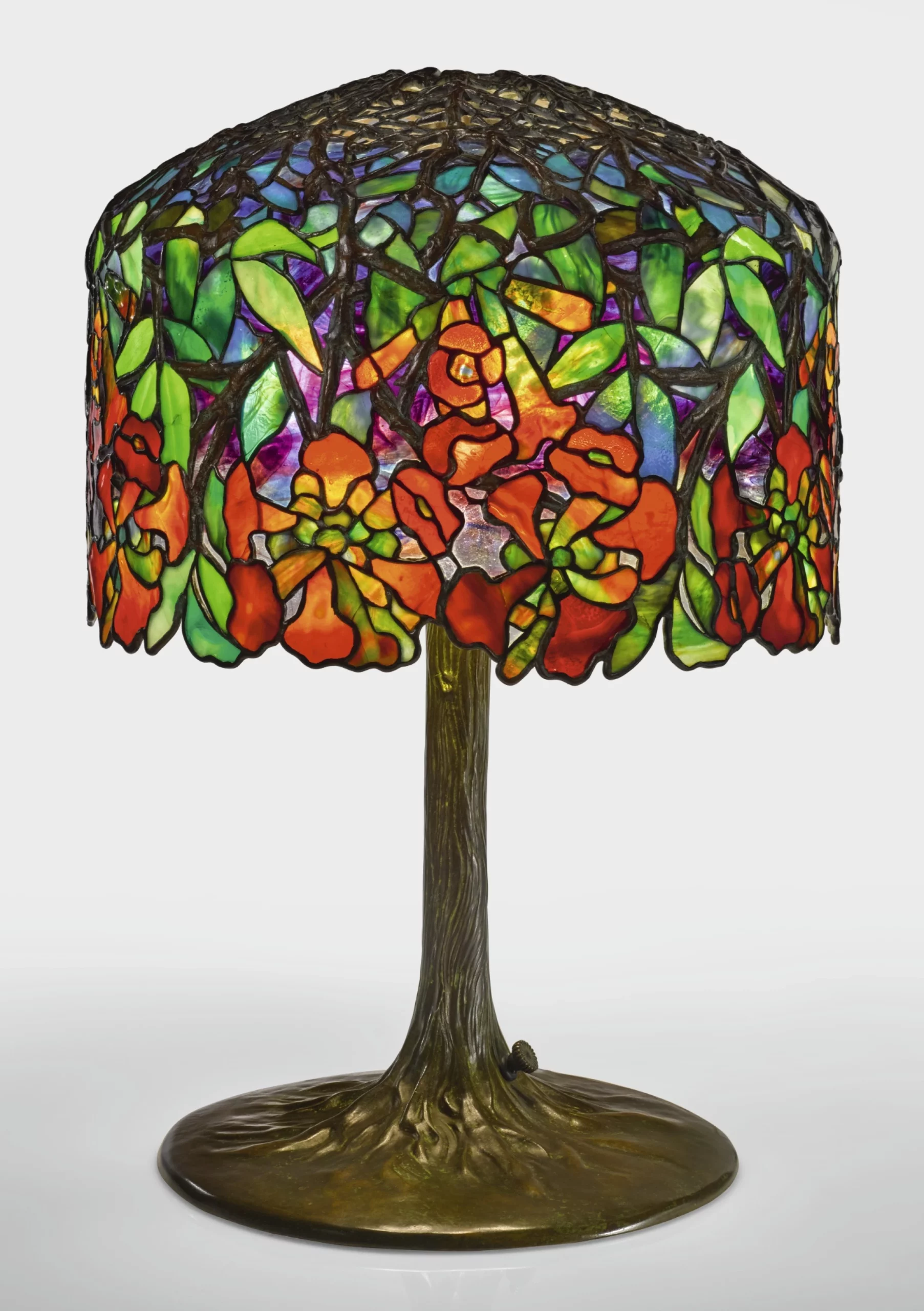
The Trumpet Creeper Table Lamp is the 3rd most expensive Tiffany Lamp in the World. The Trumpet Creeper Table Lamp is a beautiful and unique lighting piece that is perfect for any home or office space. It features a detailed and intricate design of a trumpet creeper vine, with hand-painted leaves and flowers that add a touch of whimsy to the lamp. The base is made of sturdy metal and has a sleek and modern finish, while the shade is made of white linen that helps to diffuse the light and create a warm and inviting atmosphere. The Trumpet Creeper Table Lamp is perfect for use on a nightstand, desk, or end table, and is sure to add a touch of natural charm to any room.
Tiffany Pink Lotus Lamp
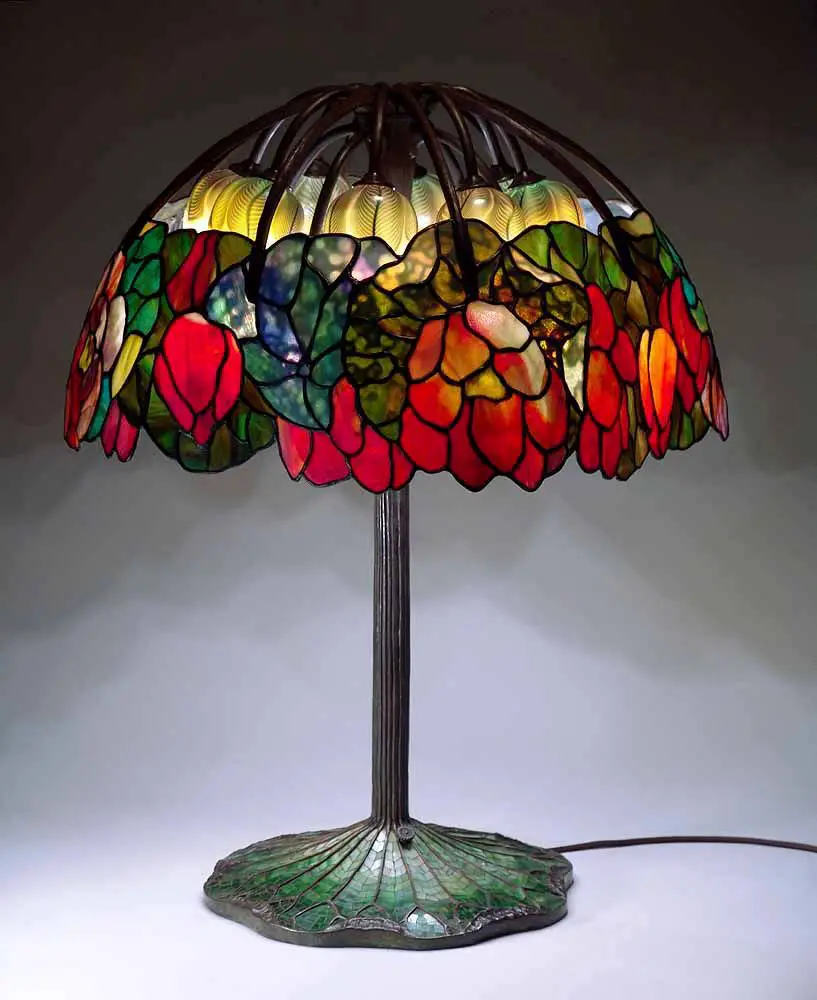
Tiffany Pink Lotus Lamp is the 2nd most expensive Tiffany Lamp in the World. The Tiffany Pink Lotus Lamp is a beautiful and delicate piece of lighting that is perfect for adding a touch of elegance and charm to any room. This lamp features a stunning pink lotus design that is handcrafted using the Tiffany method, which involves layering pieces of colored glass to create intricate and detailed patterns. The lamp is made from high-quality materials and is finished with a bronze base and matching finial. The pink lotus design is soft and feminine, making it a great choice for a bedroom or living room. It is also a great option for anyone who loves the beauty and symbolism of the lotus flower.
Tiffany’s Pond Lily Lamp
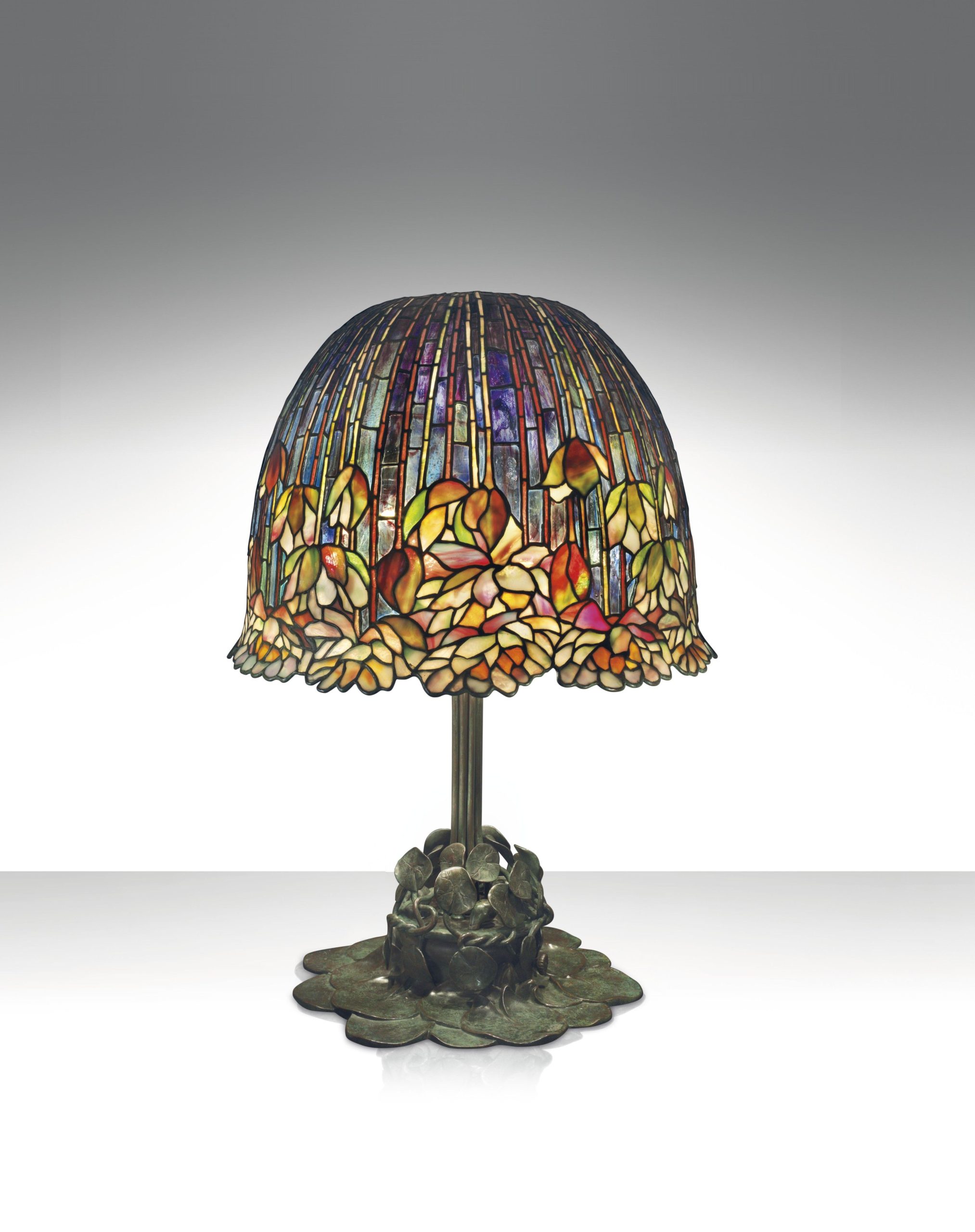
Tiffany’s Pond Lily Lamp is the most expensive Tiffany Lamp in the World. The Tiffany’s Pond Lily lamp is a beautiful and intricate piece of lighting design that is inspired by the delicate beauty of pond lilies. It features a base made of handcrafted metal, with a series of intricate glass shades arranged in a circular pattern. These shades depict the petals of a pond lily, with each one hand-painted in vibrant colors to mimic the natural beauty of the flower. The overall design of the lamp is elegant and graceful, making it a perfect addition to any room that needs a touch of timeless beauty.
Frequently Asked Questions
How to identify a Tiffany lamp?
Identifying a genuine Tiffany lamp can be challenging, as these iconic stained glass lamps are highly sought after and often imitated. Louis Comfort Tiffany was a renowned American artist and designer who created these lamps in the late 19th and early 20th centuries. Here are some steps to help you identify an authentic Tiffany lamp:
- Signature and Markings:
- Most Tiffany lamps are signed and often marked with a company name or label. Look for the signature on the base or shade. Genuine Tiffany lamps may bear a “Tiffany Studios” or “Tiffany & Co.” mark.
- Quality of Materials:
- Tiffany lamps are known for their high-quality materials. Examine the glass used in the lampshade for rich, vibrant colors, intricate patterns, and variations in texture. Tiffany used different types of glass, including opalescent, favrile, and ripple glass.
- Construction:
- Examine the lamp’s base and shade. Tiffany lamp bases are typically made of bronze, and the shades are often constructed using a leaded glass technique. The base should be sturdy and well-made, with a quality finish. Authentic Tiffany shades are handmade and feature soldered joints with smooth, consistent seams.
- Patterns and Designs:
- Tiffany lamps feature a variety of distinctive and intricate designs, including nature motifs like flowers, dragonflies, and landscapes. Familiarize yourself with the typical Tiffany patterns to help with identification.
- Tiffany Favrile Glass:
- Look for “Favrile” glass, which is a type of iridescent glass patented by Tiffany. It has a distinctive shimmer and is highly valued in Tiffany lamps and glasswork.
- Provenance:
- The history and ownership of the lamp can be crucial for authentication. If you have information about its provenance, such as records of previous owners, this can help verify its authenticity.
- Expert Appraisal:
- If you have doubts about a lamp’s authenticity, consider getting it appraised by an expert in Tiffany lamps. They can provide a professional assessment of the lamp’s origins and value.
- Compare to Reference Materials:
- Look at books, online resources, and auction catalogs that focus on Tiffany lamps. These resources can provide detailed information and images to help you compare and identify authentic Tiffany designs.
- Beware of Reproductions:
- Tiffany lamp reproductions are widespread, so be cautious when purchasing one. Do your research, and if a deal seems too good to be true, it may be a reproduction.
It’s important to note that the Tiffany Studios produced a wide variety of lamp designs, and not all genuine Tiffany lamps have the iconic “stained glass” appearance. Some, like the “Tiffany Favrile” lamps, may have different characteristics. If you’re considering purchasing a Tiffany lamp or need to authenticate one, consider consulting with experts or appraisers who specialize in Tiffany lamps for a professional evaluation.
How to make a lava lamp?
To make a lava lamp, you will need:
- A clear jar or bottle
- Water
- Food coloring
- Alka-Seltzer tablets or other effervescent tablets
- Vegetable oil
Instructions:
- Fill the jar or bottle with water, leaving about an inch of space at the top.
- Add a few drops of food coloring to the water. You can use any color you like.
- Slowly pour in vegetable oil until the jar or bottle is about 3/4 full. The oil will float on top of the water because it is less dense.
- Drop an Alka-Seltzer tablet into the jar or bottle. The tablet will react with the water and create bubbles, causing the oil to move and create a “lava lamp” effect.
- If you want the lamp to last longer, you can add more Alka-Seltzer tablets as needed.
Note: If you do not have Alka-Seltzer tablets, you can use other effervescent tablets or even baking soda and vinegar. Just be sure to follow the manufacturer’s instructions for safe use.
How long do chicks need a heat lamp?
Chicks typically need a heat lamp for the first 4-6 weeks of their life. After that, they should be able to regulate their body temperature and no longer require the heat lamp. It is important to gradually decrease the heat lamp’s intensity and duration as the chicks grow and become more able to regulate their body temperature.
How to rewire a lamp?
To rewire a lamp, you will need:
- A new lamp cord
- A wire stripper
- A pair of wire nuts
- Electrical tape
- Screwdriver
Step 1: First, unplug the lamp and remove the light bulb.
Step 2: Locate the cord where it enters the base of the lamp.
Step 3: Using the screwdriver, remove the cord clamp that holds the cord in place.
Step 4: Using the wire stripper, carefully remove the outer insulation of the cord, exposing the three wires inside.
Step 5: Remove the old cord from the base of the lamp by loosening the screws that hold it in place.
Step 6: Connect the new cord to the base of the lamp by attaching the wires to the screws. The black or red wire should go to the brass-colored screw, the white wire should go to the silver-colored screw, and the green or bare wire should go to the green-colored screw.
Step 7: Tighten the screws to secure the new cord in place.
Step 8: Using the wire nuts, connect the wires from the new cord to the wires coming from the lamp base.
Step 9: Cover the wire nuts with electrical tape to secure the connections.
Step 10: Reattach the cord clamp to hold the cord in place.
Step 11: Plug the lamp back in and test it to make sure it is working properly.
What is in a lava lamp?
A lava lamp typically contains a mixture of water, mineral oil, and a small amount of anionic or cationic surfactant. It also contains a colored dye and a small amount of a metallic or metallic-like substance, such as aluminum, which reacts with the heat generated by the light bulb in the base of the lamp to create the “lava” effect.
What does a salt lamp do?
How to make a Redstone lamp?
To make a Redstone lamp, you will need:
- Redstone dust
- A block of obsidian
- A block of flowstone
- A block of iron
- A crafting table
To make the Redstone lamp:
- Place the obsidian block in the middle of the crafting table.
- Place the glowstone block on top of the obsidian block.
- Place the iron block to the right of the obsidian block.
- Place the Redstone dust to the left of the obsidian block.
- Select the Redstone lamp in the crafting menu and place it in your inventory.
You can now use the Redstone lamp by placing it on the ground and activating it with a Redstone signal. It will emit bright light and can be used to light up dark areas or as a decorative item.
How to clean lampshades?
To clean lamp shades, follow these steps:
- Remove the lampshade from the lamp and lay it on a flat surface.
- Dust the shade with a feather duster or a soft cloth to remove any surface dirt or dust.
- If the shade is very dirty or has stains, mix a solution of mild detergent and warm water. Dip a soft cloth into the solution and gently scrub the shade, paying particular attention to any stains or areas of dirt.
- Rinse the shade thoroughly with clean water and pat dry with a clean cloth.
- If the shade is made of fabric or paper, allow it to air dry completely before replacing it on the lamp. If it is made of a more durable material, such as glass or metal, you can dry it with a clean cloth or paper towel.
- Once the shade is dry, reattach it to the lamp and turn it on to ensure it is functioning properly.
How to measure lampshades?
To measure a lampshade, you will need to follow these steps:
- Determine the shape of the lampshade: Lamp shades come in various shapes such as drum, bell, oval, square, and cone. Knowing the shape of the lampshade will help you accurately measure it.
- Measure the width: To measure the width of a lampshade, place a tape measure across the widest point of the shade. Record this measurement.
- Measure the height: To measure the height of a lampshade, place a tape measure from the top of the shade to the bottom. Record this measurement.
- Measure the fitter: The fitter is the part of the lamp shade that attaches to the lamp base. To measure the fitter, place a tape measure across the opening where the lampshade fits onto the base. Record this measurement.
- Measure the slope: If the lamp shade is a drum shape, you will also need to measure the slope. To do this, measure from the top of the shade to the bottom, at the point where the slope begins. Record this measurement.
- Measure the depth: To measure the depth of a lampshade, place a tape measure from the back of the shade to the front. Record this measurement.
- Write down all measurements: Once you have taken all of the necessary measurements, write them down and keep them handy when shopping for a new lampshade. This will help ensure that you get the correct size and fit for your lamp.
Why is my salt lamp leaking?
There could be several reasons why your salt lamp is leaking. Some possible causes include:
- The lamp is placed in a damp or humid environment. Salt lamps are made from natural salt crystals and are prone to absorbing moisture from the air. This can cause the lamp to start sweating or leaking.
- The lamp is damaged. If the lamp has cracks or chips in the salt, it may be leaking water.
- The lamp is overheating. If the lamp is placed in a location where it is exposed to high temperatures, the heat may cause the salt to start melting and leaking.
- The lamp is not being properly cared for. If the lamp is not being cleaned and maintained regularly, it may start to leak due to the build-up of dirt and grime.
To fix a leaking salt lamp, you may need to move it to a dry location, repair any damage, reduce the temperature around the lamp, or clean and maintain it properly. If the problem persists, it may be necessary to replace the lamp.
Why Tiffany lamp is so expensive?
Tiffany lamps are known for their high prices, and several factors contribute to their costliness:
- Artistic Design and Craftsmanship: Tiffany lamps are renowned for their intricate and artistic designs, often inspired by nature. Each lamp is a handcrafted work of art, and the level of detail and craftsmanship involved in creating the stained glass shades can be extraordinary.
- Materials Used: Tiffany lamps typically feature high-quality materials, including stained glass, lead, and copper foil. The stained glass used in Tiffany lamps is often custom-made, and the selection of vibrant and varied colors adds to the visual appeal.
- Originality and Rarity: Authentic Tiffany lamps are considered collector’s items, and their originality and rarity contribute to their high value. These lamps were produced in limited quantities during the late 19th and early 20th centuries by Louis Comfort Tiffany and his studio.
- Historical Significance: Tiffany lamps are considered a part of art history and design movements. The association with the Arts and Crafts and Art Nouveau movements, as well as the historical significance of Louis Comfort Tiffany’s contributions to decorative arts, adds to their value.
- Brand Recognition: The Tiffany name is associated with luxury and quality. The Tiffany & Co. brand is globally recognized, and this reputation can contribute to the perceived value of Tiffany lamps.
- Antique and Vintage Status: Many Tiffany lamps are considered antique or vintage, further enhancing their value. Collectors and enthusiasts often seek these lamps for their historical and nostalgic appeal.
- Market Demand: The demand for authentic Tiffany lamps, particularly those in good condition, drives up their prices in the market. Antique dealers, collectors, and art enthusiasts may be willing to pay a premium for these iconic pieces.
Due to these factors, authentic Tiffany lamps are often considered valuable and are sold at auctions, antique shops, and specialty galleries. It’s important to be cautious when purchasing Tiffany lamps and to ensure their authenticity, as there are also reproductions and imitations in the market.
Is my Tiffany lamp worth anything?
Determining the value of a Tiffany lamp requires careful examination and assessment, as several factors influence its worth. Here are some steps you can take to evaluate the potential value of your Tiffany lamp:
- Authentication: Ensure that your lamp is an authentic Tiffany lamp. Tiffany lamps are known for their distinctive design, high-quality materials, and craftsmanship. If possible, consult with experts, appraisers, or specialized dealers who can verify its authenticity.
- Signature and Markings: Tiffany lamps often bear a signature or marking from the Tiffany Studios. Look for a signature on the base or shade, as this can significantly affect the lamp’s value. Note that not all authentic Tiffany lamps have visible signatures.
- Condition: The condition of the lamp plays a crucial role in determining its value. Original and well-preserved Tiffany lamps in good condition are generally more valuable. Any damage, restoration, or alterations can impact the appraisal.
- Style and Design: Different styles and designs of Tiffany lamps may have different values. Certain models or designs created by specific artists may be more sought after by collectors.
- Materials Used: Tiffany lamps are known for their use of high-quality materials, including stained glass, lead, and copper foil. The quality and rarity of the materials can influence the lamp’s value.
- Provenance: The lamp’s history, including its ownership and any documentation of its provenance, can contribute to its value. If the lamp has a notable history or was owned by a significant individual, it may be more valuable.
- Market Trends: Stay informed about current market trends and recent sales of Tiffany lamps. Auction results and prices achieved for similar lamps can provide insights into the current market value.
For a comprehensive and accurate appraisal, it’s advisable to consult with a qualified appraiser or expert specializing in Tiffany lamps. Professional appraisers can consider various factors and provide a detailed assessment of the lamp’s value based on current market conditions.
Keep in mind that the value of Tiffany lamps can vary widely, and even small details can significantly impact their worth. If you’re uncertain about the value of your lamp, seeking professional guidance is crucial for an accurate appraisal.
What’s the difference between a Tiffany lamp and a Tiffany-style lamp?
The primary difference between a Tiffany lamp and a Tiffany-style lamp lies in their origin and production. Understanding this difference is crucial for collectors, enthusiasts, and buyers interested in these iconic lamps:
- Tiffany Lamp:
- Originals by Tiffany Studios: Tiffany lamps refer specifically to lamps produced by Louis Comfort Tiffany and his design studio, Tiffany Studios, during the late 19th and early 20th centuries. These lamps were handcrafted and designed by skilled artisans under the direction of Louis Comfort Tiffany himself.
- High-Quality Materials: Authentic Tiffany lamps were made with high-quality materials, including stained glass, lead, and other fine materials. The leaded glass shades were often adorned with intricate designs inspired by nature and other artistic motifs.
- Collector’s Items: Genuine Tiffany lamps are considered valuable collector’s items and are highly sought after by art and antique enthusiasts. They are often associated with the Art Nouveau and Arts and Crafts movements.
- Tiffany-Style Lamp:
- Reproductions and Imitations: Tiffany-style lamps, on the other hand, are lamps created in the style of Tiffany but are not produced by Tiffany Studios. These lamps are often reproductions or imitations inspired by the original Tiffany designs.
- Mass Production: Tiffany-style lamps are typically mass-produced and can be found in a variety of price ranges. They may be made with a range of materials, including glass, plastic, and metal, and are often manufactured in larger quantities.
- Widely Available: Tiffany-style lamps are more accessible to a broader market due to their mass production. While they may capture the aesthetic of authentic Tiffany lamps, they lack the craftsmanship, materials, and historical significance of the originals.
In summary, a Tiffany lamp specifically refers to an original, handcrafted lamp produced by Tiffany Studios during a specific historical period. Tiffany-style lamps, on the other hand, are modern reproductions or imitations inspired by the distinctive style of Tiffany but are not created by the original Tiffany Studios. When purchasing or appraising a Tiffany lamp, it’s essential to differentiate between an authentic Tiffany lamp and a Tiffany-style lamp to understand its historical value and craftsmanship.
How do you know if a Tiffany lamp is real?
Authenticating a Tiffany lamp requires careful examination, and it’s often recommended to consult with experts, appraisers, or specialists who have experience with Tiffany lamps. Here are some key factors to consider when determining if a Tiffany lamp is real:
- Signature: Many original Tiffany lamps bear a signature or marking from Tiffany Studios. However, not all authentic Tiffany lamps are signed. If a lamp is signed, the signature should be carefully examined for authenticity. Familiarize yourself with the various signatures used by Tiffany Studios.
- Materials and Construction:
- Stained Glass Quality: Genuine Tiffany lamps use high-quality stained glass, often custom-made by the studio. Examine the glass for variations in color, texture, and opalescence, which are characteristic of authentic Tiffany glass.
- Leaded Construction: Tiffany lamps are known for their leaded construction. The lead lines should be neatly soldered, and the construction should be precise.
- Design and Pattern:
- Intricate Designs: Tiffany lamps are celebrated for their intricate and detailed designs, often inspired by nature, geometric patterns, or Art Nouveau motifs. Familiarize yourself with the typical design elements used by Tiffany Studios.
- Consistency: Look for consistency in the design and pattern across the lampshade. Authentic Tiffany lamps exhibit meticulous craftsmanship and attention to detail.
- Base and Hardware:
- Bronze Base: Original Tiffany lamps often feature bases made of bronze. Examine the base for signs of quality craftsmanship and details such as patina, which may develop over time.
- Hardware Details: Authentic Tiffany lamps have hardware, such as screws and sockets, that match the period of production. Inconsistent or modern hardware may indicate a reproduction.
- Provenance: If possible, research the lamp’s provenance or history of ownership. Documentation supporting its authenticity, such as receipts, photographs, or records, can contribute to the lamp’s credibility.
- Expert Consultation: When in doubt, seek the expertise of professionals who specialize in Tiffany lamps. Art appraisers, antique dealers, or Tiffany lamp specialists can provide valuable insights and authentication services.
Keep in mind that reproductions and forgeries of Tiffany lamps exist, so a thorough examination by an expert is essential for reliable authentication. If you are considering purchasing a Tiffany lamp or seeking authentication, consult with reputable experts or organizations with expertise in Tiffany lamps and decorative arts.
Why are Tiffany lamps popular?
Tiffany lamps are popular for several reasons, and their enduring appeal can be attributed to a combination of artistic, historical, and aesthetic factors:
- Artistic Design: Tiffany lamps are celebrated for their unique and intricate designs. The lampshades, often made of stained glass, feature vibrant colors, intricate patterns, and motifs inspired by nature, including flowers, insects, and landscapes. The artistic craftsmanship and attention to detail contribute to their aesthetic appeal.
- Tiffany Studios Legacy: Louis Comfort Tiffany, the designer behind Tiffany lamps, was a prominent figure in the Art Nouveau and Arts and Crafts movements. The lamps were produced by Tiffany Studios during the late 19th and early 20th centuries. The association with Tiffany’s legacy and the historical significance of his studio contribute to the lamps’ popularity.
- Craftsmanship: Tiffany lamps were handmade by skilled artisans at Tiffany Studios. The craftsmanship involved in creating these lamps, including the leaded glasswork and bronze bases, is highly regarded. Each lamp was a work of art, showcasing meticulous attention to detail.
- Variety of Styles: Tiffany lamps come in various styles, sizes, and designs. This diversity allows collectors and enthusiasts to find lamps that suit their personal preferences and complement different interior styles. Whether it’s a floral design, geometric pattern, or dragonfly motif, there is a wide range of options.
- Iconic Stained Glass: The use of stained glass in Tiffany lamps is iconic. The method of selecting, cutting, and assembling individual pieces of glass to create a cohesive and visually striking whole is a distinctive feature. The play of light through the stained glass adds to the lamps’ charm.
- Collector’s Items: Authentic Tiffany lamps are considered valuable collector’s items. Their rarity and historical significance contribute to their desirability among collectors and art enthusiasts. The limited production during Tiffany Studios’ existence adds to their exclusivity.
- Timeless Elegance: Tiffany lamps exhibit a timeless elegance that transcends design trends. Their enduring popularity is not confined to a specific era, making them suitable for both traditional and contemporary interiors.
- Status Symbol: Tiffany lamps are associated with luxury and have become a status symbol. Owning an authentic Tiffany lamp is a statement of appreciation for art, craftsmanship, and historical legacy.
Overall, the popularity of Tiffany lamps can be attributed to their artistic beauty, historical significance, craftsmanship, and the legacy of Louis Comfort Tiffany and Tiffany Studios. Their appeal has endured for over a century, making them sought after by collectors and admired by those who appreciate fine art and design.
What makes a lamp look expensive?
Several factors contribute to making a lamp look expensive, and these factors often revolve around design, materials, craftsmanship, and attention to detail. Here are some elements that can make a lamp appear luxurious and expensive:
- High-Quality Materials:
- Premium Metals: Expensive lamps often use high-quality metals such as brass, bronze, nickel, or even precious metals like gold or silver. These materials provide durability and a luxurious appearance.
- Fine Wood: Lamps with bases or components made from high-quality wood, such as mahogany, walnut, or exotic hardwoods, convey a sense of luxury.
- Artisan Craftsmanship:
- Handcrafted Details: Lamps that are handcrafted and feature intricate details showcase artisan craftsmanship. Hand-carved or hand-applied details can elevate the lamp’s aesthetic and perceived value.
- Custom Finishes: Custom finishes, such as hand-applied patinas or unique paint treatments, add to the lamp’s exclusivity.
- Exquisite Design:
- Unique and Original Designs: Expensive lamps often feature unique and original designs that set them apart. Designs that showcase creativity, innovation, or artistic expression contribute to their luxurious appeal.
- Designer or Artisan Collaborations: Lamps designed by well-known designers or created through collaborations with renowned artisans can carry a premium due to their association with the designer’s reputation.
- Premium Lampshades:
- High-Quality Fabrics: The choice of fabric for lampshades, such as silk, linen, or other luxurious materials, can contribute to the lamp’s overall elegance.
- Hand-Painted or Embroidered Shades: Lampshades with hand-painted or embroidered details require skilled craftsmanship and can enhance the lamp’s visual appeal.
- Customization:
- Personalization: Customization options, such as the ability to choose finishes, materials, or lampshade designs, can make a lamp feel more exclusive and tailored to the buyer’s preferences.
- Innovative Lighting Technology:
- Smart Features: Lamps with modern and smart features, such as adjustable brightness, color temperature control, or compatibility with smart home systems, can contribute to a contemporary and high-tech appearance.
- Presentation and Packaging:
- Luxurious Packaging: The way a lamp is presented and packaged can influence its perceived value. High-quality packaging materials and thoughtful presentation enhance the overall buying experience.
- Brand Reputation:
- Designer or Luxury Brands: Lamps from well-known designer brands or luxury lighting companies often come with a premium price tag due to the brand’s reputation for quality and style.
- Size and Scale:
- Substantial Size: Larger lamps with a substantial presence can command attention and convey a sense of luxury. The size and scale of a lamp contribute to its visual impact.
Ultimately, the perceived expense of a lamp is a subjective judgment influenced by a combination of these factors. Whether it’s the choice of materials, the craftsmanship, or the overall design, a luxurious lamp often reflects a commitment to quality and aesthetics.
Why do Tiffany lamps have dragonflies?
Tiffany lamps frequently feature nature-inspired motifs, and one of the recurring themes found in these lamps is the dragonfly. Louis Comfort Tiffany, the designer behind Tiffany lamps, drew inspiration from nature, and the dragonfly motif was a popular choice for several reasons:
- Symbolism: Dragonflies are rich in symbolism and are associated with positive qualities in various cultures. They are often seen as symbols of transformation, change, adaptability, and the beauty of life. The dragonfly’s ability to dart and hover over water also connects it to the element of water and its symbolic meanings.
- Artistic Aesthetics: The delicate and ethereal appearance of dragonflies makes them visually appealing and well-suited for artistic expression. The intricate wings, slender bodies, and vibrant colors of dragonflies provided Tiffany Studios with a wealth of design possibilities.
- Capturing Nature’s Beauty: Tiffany had a deep appreciation for the beauty of the natural world, and he sought to capture that beauty in his designs. The dragonfly motif allowed him to bring a touch of nature into interior spaces, creating lamps that were not only functional but also works of art.
- Color Variation: Dragonflies come in a variety of colors, and this color diversity provided Tiffany Studios with opportunities to showcase their expertise in creating stained glass. The wings of dragonflies, in particular, offered a canvas for intricate and varied patterns, allowing for the use of multiple shades and textures of glass.
- Art Nouveau Influence: Tiffany lamps are often associated with the Art Nouveau movement, which embraced organic and flowing forms inspired by nature. Dragonflies were a popular motif during the Art Nouveau era, and their inclusion in Tiffany lamps aligns with the broader artistic trends of the time.
- Personal Fascination: Louis Comfort Tiffany had a personal fascination with insects and nature. His interest in entomology, the scientific study of insects, likely influenced his choice to incorporate insect motifs, including dragonflies, into his designs.
The dragonfly motif became an iconic element in Tiffany lamps, appearing in various styles and designs. Whether hovering over floral arrangements or depicted in a more abstract form, dragonflies added a sense of whimsy, beauty, and symbolism to Tiffany’s creations. Today, dragonfly Tiffany lamps are highly sought after by collectors and are admired for their timeless beauty and artistic expression.
When did Tiffany stop making lamps?
Tiffany Studios, the company founded by Louis Comfort Tiffany, faced financial challenges in the 1920s, exacerbated by changing tastes and economic conditions. In 1928, Tiffany Studios declared bankruptcy, marking the end of its operations. Consequently, the production of Tiffany lamps and other decorative art items ceased.
The bankruptcy and closure of Tiffany Studios marked the conclusion of an era in which Louis Comfort Tiffany and his team had created some of the most iconic and beautiful stained glass lamps, windows, and decorative objects. After the closure, many of the original Tiffany lamps remained highly sought after, and they continue to be cherished as valuable and collectible items today.
It’s important to note that while Tiffany Studios itself ceased operations in 1928, the legacy of Louis Comfort Tiffany’s designs and the popularity of Tiffany lamps persisted. In subsequent years, there have been reproductions and adaptations inspired by the original Tiffany designs, but these are distinct from the creations produced by Tiffany Studios during its active period. Collectors and enthusiasts often differentiate between authentic Tiffany lamps produced during the studio’s existence and later reproductions or Tiffany-style lamps created by other manufacturers.
What does the bottom of a Tiffany lamp look like?
The bottom of a Tiffany lamp typically consists of the lamp’s base, which is a critical component providing support and stability. The design of the base can vary depending on the specific model and style of the Tiffany lamp. Here are some common features you might find on the bottom of a Tiffany lamp:
- Base Material: Tiffany lamps often have bases made of metal, and bronze was a commonly used material. The base may have intricate detailing, such as sculpted patterns, motifs, or textured finishes. The choice of metal and the quality of craftsmanship contribute to the lamp’s overall aesthetic.
- Signature or Marking: Some Tiffany lamps bear a signature, marking, or label from Tiffany Studios. The signature is typically located on the metal base, and it can include variations such as “Tiffany Studios New York,” “L.C.T.,” or a combination of letters associated with Louis Comfort Tiffany’s name.
- Patina: Over time, metal surfaces can develop a patina, which is a thin layer that forms due to oxidation. The patina can add character and depth to the base, and its presence is often considered a desirable feature in antique lamps.
- Footed Design: The bottom of the lamp’s base may have feet or a footed design to provide stability. These feet may be simple and functional or decorative, complementing the overall design of the lamp.
- Finish: The base may have a specific finish, such as a polished, matte, or antique finish. The choice of finish contributes to the lamp’s overall appearance and can enhance its vintage or contemporary appeal.
- Overall Design Harmony: The design elements on the base are often harmonized with the lampshade to create a cohesive and visually appealing whole. For example, if the lampshade features dragonfly motifs, floral patterns, or geometric shapes, similar design elements may be echoed on the base.
Keep in mind that the specific features on the bottom of a Tiffany lamp can vary widely depending on the model, style, and individual design choices made by Tiffany Studios. If you are curious about the details of a specific Tiffany lamp, examining it in person or consulting with experts and appraisers who specialize in Tiffany lamps can provide more precise information about its base and overall authenticity.
Are Tiffany lamps out of style?
Tiffany lamps continue to be appreciated for their artistic beauty and craftsmanship, and they have not gone out of style. These iconic lamps, known for their stained glass shades and intricate designs, have a timeless appeal that transcends design trends. Here are a few reasons why Tiffany lamps remain popular and are considered classic:
- Artistic Aesthetics: Tiffany lamps are celebrated for their unique and intricate designs inspired by nature, geometric patterns, and other artistic motifs. The combination of vibrant stained glass and finely crafted metalwork creates a visually stunning and timeless aesthetic.
- Craftsmanship: The meticulous craftsmanship involved in creating Tiffany lamps is highly valued. Each lamp is a handcrafted work of art, showcasing the skill of the artisans who produced them. The leaded glasswork, soldering, and attention to detail contribute to their enduring appeal.
- Versatility: Tiffany lamps come in a variety of styles, sizes, and designs, making them versatile and suitable for various interior styles. Whether placed in traditional or contemporary settings, Tiffany lamps can complement a wide range of decor.
- Collectible and Antique Appeal: Original Tiffany lamps produced during the late 19th and early 20th centuries are considered valuable collector’s items. Their historical significance, association with Louis Comfort Tiffany, and limited production during Tiffany Studios’ existence contribute to their antique appeal.
- Symbolic Motifs: Many Tiffany lamps feature nature-inspired motifs such as dragonflies, flowers, and landscapes. These symbolic motifs, along with the use of vibrant colors, add depth and meaning to the designs.
- Status as Design Classics: Tiffany lamps are often associated with the Art Nouveau and Arts and Crafts movements. Their status as design classics means they hold a special place in the history of decorative arts and design.
While contemporary interior design trends may evolve, Tiffany lamps remain relevant due to their enduring beauty, historical significance, and appreciation for handcrafted, artisanal pieces. Additionally, modern reproductions and adaptations inspired by Tiffany’s designs continue to be produced, allowing new generations to enjoy the timeless elegance of these iconic lamps.
Are real Tiffany lamps marked?
Yes, many authentic Tiffany lamps are marked with a signature or other identifying mark from Tiffany Studios. These marks are typically found on the lamp’s base, near the socket, and may include variations of the following:
- Tiffany Studios Mark: Some lamps are marked with “Tiffany Studios New York,” often followed by a model or style number. This is one of the most common markings found on authentic Tiffany lamps.
- Tiffany Signature (L.C.T.): Louis Comfort Tiffany’s initials, “L.C.T.,” are sometimes used as a signature on lamps. This marking reflects the personal association of the lamp with Tiffany himself.
- Tiffany & Co. Mark: In some cases, the mark “Tiffany & Co.” may appear. However, it’s important to note that Tiffany & Co. is the jewelry retailer founded by Charles Lewis Tiffany and is distinct from Tiffany Studios, which produced decorative arts and lamps.
It’s crucial to examine the marking carefully and to be aware that not all authentic Tiffany lamps are signed. Some earlier models or experimental pieces may lack a visible signature, and some signatures may be more discreet or located in less conspicuous areas.
If you’re uncertain about the authenticity of a Tiffany lamp, consulting with experts, appraisers, or Tiffany lamp specialists can provide valuable insights. They can examine the lamp, its markings, and other details to authenticate its origin and provide information about its age, style, and potential value. Keep in mind that there are also reproductions and imitations in the market, so thorough authentication is essential for collectors and enthusiasts.













